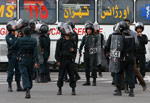 AP: Iran deployed squads of riot police around the major intersections of the capital Sunday, bracing for any kind of violent backlash in the tightly controlled Islamic Republic on the day deep cuts in food and energy subsidies went into effect.
AP: Iran deployed squads of riot police around the major intersections of the capital Sunday, bracing for any kind of violent backlash in the tightly controlled Islamic Republic on the day deep cuts in food and energy subsidies went into effect.
The Associated Press
 TEHRAN, Iran (AP) — Iran deployed squads of riot police around the major intersections of the capital Sunday, bracing for any kind of violent backlash in the tightly controlled Islamic Republic on the day deep cuts in food and energy subsidies went into effect.
TEHRAN, Iran (AP) — Iran deployed squads of riot police around the major intersections of the capital Sunday, bracing for any kind of violent backlash in the tightly controlled Islamic Republic on the day deep cuts in food and energy subsidies went into effect.
Angry taxi drivers complained as the price of fuel rose four times overnight in one of the world’s leading oil producers.
“I don’t know what to do,” said one frustrated cab driver, who did not want to be identified for fear of retribution by authorities. “I am not allowed to increase price of my service while I am paying five times more than yesterday.”
A truck driver said he paid ten times more on Sunday for natural gas to fuel his vehicle.
“If I raise my prices, people will not be able to afford it. Or they may report me,” said Mansour Abbasi, 43.
President Mahmoud Ahmadinejad announced on Saturday night that the subsidy cuts, long expected, would go into effect at midnight. Though Iran has tremendous oil wealth, its economy appears to be straining under the weight of four rounds of U.N. sanctions over its disputed nuclear program.
Tehran says it is paying some $100 billion in subsidies annually, although experts believe the amount is far lower, closer to $30 billion. Iran had planned to slash subsidies before the latest round of sanctions took effect — Ahmadinejad and his allies have long insisted the country’s oil-based economy could no longer afford the largesse.
Economists say the unpopular plan to slash subsidies could stoke inflation already estimated to be more than 20 percent.
Before the subsidy cuts, Iran had some of the cheapest gasoline in the world.
Under the new rationing system, each personal car receives 60 liters (16 gallons) of subsidized fuel a month costing 40 cents a liter ($1.50 a gallon) — up from the just 10 cents a liter. Further purchases of gas would run 70 cents a liter ($2.69 a gallon), up from just 40 cents.
One lawmaker said he had expected the extent of price rises overnight to happen gradually over five years.
“I am surprised. We do not know what happened,” the lawmaker told the Associated Press on condition of anonymity because he was not authorized to comment. “The price of fuel was supposed to reach about international prices within the next five years and not this year.”
Witnesses reported a heavy police presence around the capital Tehran, though there were no reports of violence so far. Calm was also reported in other major such as Tabriz, Kermanshah, Bandr Abbas , Kerman and Ahvaz. One resident of Ahvaz said some taxi fares doubled.
In 2007, angry protesters set dozens of gas stations on fire after the government imposed a new system of gasoline rationing to cut down on access to the country’s heavily subsidized fuel.
Ahmad Bakhshayesh, a Tehran University professor of politics, said it was too soon to gauge the public reaction to the cuts, and popular unrest could still erupt.
“We have to wait and see how inflation will affect their lives,” he told AP.
After the president announced the cuts late Saturday night, long lines of cars formed at gas stations in Tehran as Iranians rushed to fill their tanks at subsidized prices before the new ones took effect at midnight. By Sunday, the lines were gone.
Economic analyst Saeed Laylaz said the cuts were in theory a positive move since they would reduce energy consumption, which is currently costing the country a quarter of its Gross National Product.
“However it is being implemented in an incomplete fashion because it’s not accompanied by a greater liberalization of the economy,” he said, adding that the cuts would probably not have much positive effect.
Ahmadinejad also said his government was paying $4 billion in bread subsidies, which will also gradually be phased out.
The government says it will return part of the money obtained from increased prices to the people through cash payments. It has already paid into accounts of some 20 million families as compensation ahead of the cuts.
Every family member will now receive $80 for to help them over the next two months.


